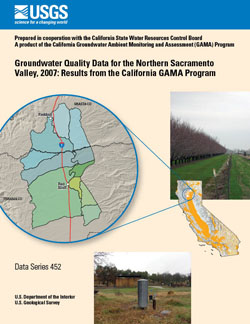Data Series 452
ABSTRACT
Groundwater quality in the approximately 1,180-square-mile Northern Sacramento Valley study unit (REDSAC) was investigated in October 2007 through January 2008 as part of the Priority Basin Project of the Groundwater Ambient Monitoring and Assessment (GAMA) Program. The GAMA Priority Basin Project was developed in response to the Groundwater Quality Monitoring Act of 2001, and is being conducted by the U.S. Geological Survey (USGS) in cooperation with the California State Water Resources Control Board (SWRCB). The study was designed to provide a spatially unbiased assessment of the quality of raw groundwater used for public water supplies within REDSAC and to facilitate statistically consistent comparisons of groundwater quality throughout California. Samples were collected from 66 wells in Shasta and Tehama Counties. Forty-three of the wells were selected using a spatially distributed, randomized grid-based method to provide statistical representation of the study area (grid wells), and 23 were selected to aid in evaluation of specific water-quality issues (understanding wells). The groundwater samples were analyzed for a large number of synthetic organic constituents (volatile organic compounds [VOC], pesticides and pesticide degradates, and pharmaceutical compounds), constituents of special interest (perchlorate and N-nitrosodimethylamine [NDMA]), naturally occurring inorganic constituents (nutrients, major and minor ions, and trace elements), radioactive constituents, and microbial constituents. Naturally occurring isotopes (tritium, and carbon-14, and stable isotopes of nitrogen and oxygen in nitrate, stable isotopes of hydrogen and oxygen of water), and dissolved noble gases also were measured to help identify the sources and ages of the sampled ground water. In total, over 275 constituents and field water-quality indicators were investigated. Three types of quality-control samples (blanks, replicates, and sampmatrix spikes) were collected at approximately 8 to 11 percent of the wells, and the results for these samples were used to evaluate the quality of the data obtained from the groundwater samples. Field blanks rarely contained detectable concentrations of any constituent, suggesting that contamination was not a noticeable source of bias in the data for the groundwater samples. Differences between replicate samples were within acceptable ranges for nearly all compounds, indicating acceptably low variability. Matrix-spike recoveries were within acceptable ranges for most compounds. This study did not attempt to evaluate the quality of water delivered to consumers; after withdrawal from the ground, raw groundwater typically is treated, disinfected, or blended with other waters to maintain water quality. Regulatory thresholds apply to water that is served to the consumer, not to raw ground water. However, to provide some context for the results, concentrations of constituents measured in the raw groundwater were compared with regulatory and nonregulatory health-based thresholds established by the U.S. Environmental Protection Agency (USEPA) and California Department of Public Health (CDPH) and with aesthetic and technical thresholds established by CDPH. Comparisons between data collected for this study and drinking-water thresholds are for illustrative purposes only and do not indicate compliance or noncompliance with those thresholds. The concentrations of most constituents detected in groundwater samples from REDSAC were below drinking-water thresholds. Volatile organic compounds (VOC) and pesticides were detected in less than one-quarter of the samples and were generally less than a hundredth of any health-based thresholds. NDMA was detected in one grid well above the NL-CA. Concentrations of all nutrients and trace elements in samples from REDSAC wells were below the health-based thresholds except those of arsenic in three samples, which were above the USEPA maximum contaminant level (MCL-US). However, none of these wells were public-supply wells. Concentrations of all radioactive constituents were below health-based thresholds except radon-222, which was detected above the proposed MCL-US of 300 pCi/L in samples from 11 grid wells. Most of the samples from REDSAC wells had concentrations of major elements, total dissolved solids, and trace elements below the non-enforceable thresholds set for aesthetic or technical concerns. A few samples contained iron, manganese, or pH at levels above the SMCL-CA or SMCL-US thresholds. |
For additional information contact: Part or all of this report is presented in Portable Document Format (PDF); the latest version of Adobe Reader or similar software is required to view it. Download the latest version of Adobe Reader, free of charge. |
Bennett, P.A., Bennett, G.L., V, Belitz, Kenneth, 2009, Groundwater quality data in the northern Sacramento Valley, 2007: Results from the California GAMA program: U.S. Geological Survey Data Series 452, 90 p.
Abstract
Introduction
Methods
Water Quality Results
Summary
Acknowledgments
References
Tables
Appendix